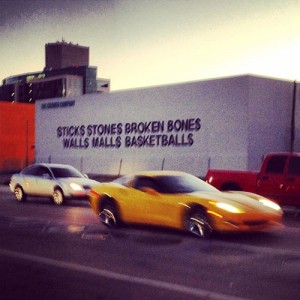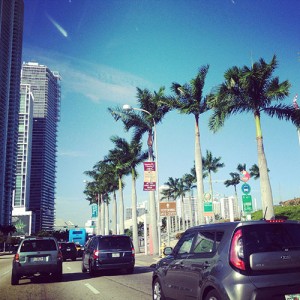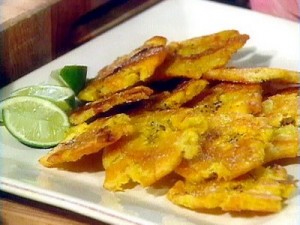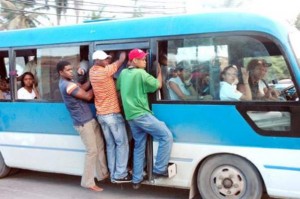Above: Well organized signage from my local market, Presidente
Floridians say Miami is not really a part of America, that in fact it really is an extension of Latin America. I have only lived in one Latin American country, the Dominican Republic, so I’m no expert, but I did live there for 8 years… Now I have been Miami for over 6 months and in many, many ways I do feel like I’m back in the Dominican Republic, but in others I see a clear difference. So I decided to create a list of 10 ways Miami is just the same as Santo Domingo, 10 ways Miami is not as good as Santo Domingo and 10 ways Miami is better than Santo Domingo. What might seem surprising for many is that I found it harder to come up with 10 ways Miami is better than Santo Domingo — I guess I’m still an expat at heart…
10 Ways Miami is Identical to Santo Domingo
-
I can buy platanos, yuca and yauita at my corner market
My local market is called Presidente, just like the famous Dominican beer, and when you walk in you see rows of viveres (starch root vegetables) and various members of the banana family: plantains, green bananas, rulos (short, fat green bananas) as well as piles of rice, beans and corn, all staples of the Latin diet. Here I describe my first experience visiting this market and being in Miami in general. - You need to speak Spanish to get around easily
Although you can get by with just English in many places (believe it or not this is true for the Dominican Republic too even though their English is worse), if you don’t speak Spanish you can miss a lot of important information and find yourself in the dark - The rules and regulations of anything government run (schools, cops, DMV) are convoluted and downright contradictory
I describe the convoluted experience with the Miami-Dade school system in my Miami Me Mueve post and since then it has been even more complicated, especially when it comes to communication. For example, in North Florida, I got regular communication from my children’s teachers and if they behaved badly I was notified, if they were having trouble with their studies, a conference would be arranged. Not in Miami, no…it’s just like the Third World. No communication; no one knows anything. My daughter was doing great in school and then got an F in reading. I knew she had been having trouble in her previous school but she made honors the first report card at her new school so I thought she was doing better. I call the teacher who was so casual about it and even seemed even a bit annoyed that I called. I then started tutoring my daughter to bring her grade up by the end of the year but I wish I had known before so I could have made more progress. -

Miami is known for it’s fast cars
People drive like maniacs, disrespecting traffic rules, and just about every car you see has a dent in it
In the Dominican Republic you can’t even get insurance for cars older than 5 years and hardly anyone has insurance at all. In Miami a few more have it but judging by the number of dented cars and their crazy weaving in and out of lanes, the driving quality is about the same. - Random intense rainstorms which rapidly flood the streets
South Beach is just like the Malecón in Santo Domingo when it rains. The streets fill with water and traffic gets jammed up. In my home area of North Miami there is better drainage but the rain still is fierce and strong. My backyard floods in a manner of minutes. - The same burning tropical heat and lush humidity
Climate-wise Miami is near identical of Santo Domingo with the exception of a few days that get cool in the winter. - Avocado and Mango seasons are so bountiful that they practically ambush the landscape and the fruit is often there for the taking
Trees dripping with fruit are everywhere. I used to measure the year in the Dominican Republic by mango season in June and avocado season in September. In Miami the mangos are bigger, different strain, and you see a wider variety of avocados but the seasons and their bounty are nearly the same. -

Palm trees line downtown Miami
People are either in a crazy hurry or going nowhere fast
You can probably say this about other places too but indicative of the tropical zone is that there is no middle ground. In the Dominican Republic you will see cars drive as fast as the street will allow, regardless of location and I see that in Miami too. But in contrast other drivers seem to be in dreamland, barely moving, making everyone else crazy. - A windstorm means coconut fronds will scatter the streets
Coconut palms are everywhere in both locations and one always have to be alert for a frond about to fall. When it gets stormy, the streets get messy fast. - Public events always have a (loud) soundtrack
Latin culture is not quiet. It is loud and strong and very musical.
10 Ways Miami is Not as Good as Santo Domingo

Presidente, the national beer, can be ordered at any colmado ice cold
- There are no colmados that will deliver beer and other essentials
Colmados range from little hole-in-the-wall shops to convenience stores with a dining area but they all have one thing in common: they deliver. By deliver, I mean everything from 5 gallon jugs of water, to a few ounces of laundry soap to an icy cold beer. Colmados are one of the few luxuries that Dominicans enjoy. - You can actually get stopped for speeding
In the Dominican Republic, speeding tickets don’t exist and posted speed signs are rare or completely ignored. The police are not paid enough to be bothered with enforcing something so minor as a speeding ticket. Whereas in Miami, speeding tickets account for a lot of city income. - You can’t get out of that speeding ticket by offering the police officer a thousand pesos (about $25)
In Miami, it wouldn’t be a good idea to offer a police officer money to get out of a ticket but in the Dominican Republic it’s actually expected. - You can’t buy fresh empanadas or chimi sandwiches on street corners
While you may encounter an occasional food truck in Miami, you do not see the plethora of street food goodness that you can find in Santo Domingo. - You don’t hear music everywhere
You hear music in Miami but in the Dominican Republic you hear it everywhere and that just makes life more fun. -

Traditional dancers in the Dominican Republic
People don’t randomly start dancing when working
In line with #5, the music means that life is danceable and dance they do, everywhere, every time they can, even while working jobs like waiting tables or collecting money for a bus ride, you will see their hips swing. - There is (a lot) fewer smiles and laughter
See #s 5 & 6 - Life is more predictable (and therefore far less interesting) because no one can blame power outages, craters in the road, or lack of cell phone coverage for why something can’t get done
We Americans love how we can multitask, plan ahead, coordinate our day down to the minute and get super irritated when things don’t go according to plan. None of that applies to life in the Third World. Schedules don’t mean anything and that means life is full of surprises both from real situations that arise and those that are made up to avoid getting something done. Either way it is a kind of freedom, freedom from time that we don’t have in the United States where things do actually work. - The cost of healthcare in the Dominican Republic is about 1/10 the cost of US healthcare for equivalent services (same is true of child care)
The economic disadvantages of living in the Third World are obvious but there are also real economic advantages to living there, especially with young children and they are: health care and child care. Both my children were born in Santo Domingo and the cost of their deliveries were about $1500 for the first because it was cesarean and $1200 for the second because it was a natural delivery. I had no health insurance.That is for everything including 2 nights stay in the hospital. For childcare I had a live-in, full-time nanny for about $400 per month. - As exotic as Miami may be at times, you are still actually in the United States
If you are like me, you crave the different, the exotic. Miami can come close at times but it is still a part of the U.S.
10 Ways Miami is Better Than Santo Domingo
-
When the power goes out it is for all of a split second
Miami is known for it’s glittering downtown and light displays and that is possible because of stable power. - The traffic lights work and are actually used (most of the time)
Due to steady power you don’t have traffic lights going out all over the place like you do in Santo Domingo. This dramatically improves traffic flow. In addition, in the Dominican Republic, working traffic lights are often “overruled” by metropolitan police officers directing traffic to move in direct opposition to what the lights are indicating which makes for a crazy mess. - The police are honest and law-abiding (most of the time)
Having a police force than you can actually trust to protect you, even if they are not perfect is a lot better than a police force that may actually do more harm than good. - The fire department and ambulance will come when you call them
When you grow up in a developed country it is hard to imagine that there is no guarantee of help arriving. Recently the Dominican Republic has initiated its form of 911 but like many things in the Third World, it remains unreliable. -

Dining out in the Dominican Republic is costly
There isn’t a 26% tax when you go out to eat
Taxes in the Dominican Republic, especially on food and drink are outrageous. - There is public access to information such as public documents and you can actually get copies if you ask nicely
I once wrote a post about how the access to information can make such a difference in one’s freedom and that lack of access is one of the biggest issues Third World countries need to address in order to progress. - In less than an hour you can be in “America” (Ft. Lauderdale)
Although the Dominican Republic is quite diverse for such a small island, it is still a united, consistent culture and as someone who grew up in NYC, I came to miss the variety of a big city. Miami is so Latin and Caribbean but just a short drive away is Ft. Lauderdale which, although has a Latin population as well, is so very different in tone, much more like mainstream America, at least as compared to Miami. - It is actually possible to earn a decent living working for someone else
One of the challenges I faced living in the Dominican Republic was that outside of running my own business I had no other options financially to support myself. This was because the scale of income was so much lower compared to the expenses. For example, my expenses were around $2500 per month with two children. This is living lower middle class. But a professional designer wage was less than $1000 per month, an amount I can earn in a week in the U.S. -

A local bus known as a “guagua” often ran on propane which created a nasty black smoke.
The air is cleaner (the abundance of diesel and propane vehicles in Santo Domingo create nasty pollution)
Santo Domingo, like any Third World capital is very congested and has no emissions control. Add to that the cost of gasoline in a poor country and their solution is more diesel, which is cheaper, and propane, both of which create nasty fumes. - You can buy plain, unsweetened yogurt and other important ingredients (just not at Presidente…)
This may seam like a small thing but it was a huge pet peeve of mine when I lived in the Dominican Republic. As some who loves to cook, I appreciate the abundance and variety of ingredients I have access to here in the United States as well as their overall quality due to consistent refrigeration.


